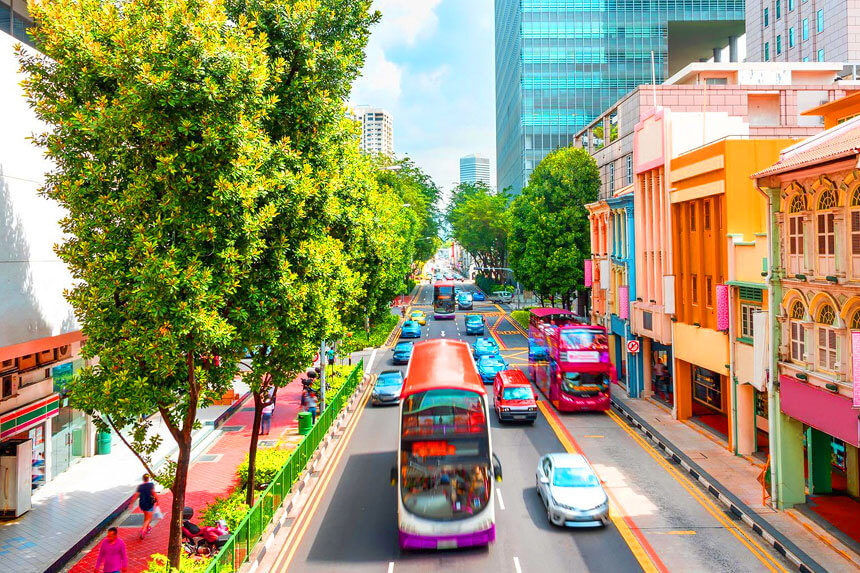Getting from Singapore to Johor Bahru is easier than ever in 2025. You have six main options: buses starting at S$2, the 5-minute KTM Shuttle Tebrau train for S$5, private taxis, rental cars, coaches, and limousines. Each option suits different budgets and travel styles, with improved border queue times and digital immigration making cross-border transport faster than before.
- Transport from Singapore to JB
- Travel Modes: Quick Comparison of Bus, Train, Car, Taxi, Coach, and Limo
- How to Book and Expected Costs per Option
- Current Travel Alerts and Delays (Bus Strike, Border Queues, Holiday Peaks)
- Upcoming Changes: RTS Link 2026 and End of Shuttle Tebrau
- Tips from Real Travelers: Beat Congestion, Save Time, Use E-gates
- Bottom Line for Smart Cross-Border Travel
Transport from Singapore to JB
The journey across the Causeway takes 45 minutes to 1.5 hours depending on your chosen transportation and border queue length. From September 15, 2025, Singapore’s cross-border bus services now start at 4:50am on weekdays—10 minutes earlier than before—to tackle early morning congestion . This Southeast Asian transit network connects two major urban centers with remarkable efficiency.
Bus services run every 3-5 minutes during peak hours via Causeway Link (CW buses) and SBS Transit. The KTM Shuttle Tebrau operates 13 daily departures from Singapore and 18 from JB. Private options like taxis and rental cars offer door-to-door convenience but cost significantly more. This cross-border travel system, rooted in the Latin “transportare” meaning “to carry across,” has evolved into one of the world’s busiest international commuting corridors.
Recent upgrades include additional Malaysia e-gates since early 2025, making immigration clearance much faster even on weekends . Digital technology has sped up immigration checks, while new highways and e-payment systems have streamlined journeys across this vital mobility link.
Travel Modes: Quick Comparison of Bus, Train, Car, Taxi, Coach, and Limo
Public transport via buses remains the most affordable option at S$1.85-4.80 per trip. Causeway Link buses (CW1, CW2, CW5) use dedicated bus lanes at checkpoints, potentially saving hours compared to cars stuck in traffic . Peak frequency runs every 3-5 minutes, with vehicles designed for cross-border efficiency.
Train transport via KTM Shuttle Tebrau takes exactly 5 minutes between Woodlands Train Checkpoint and JB Sentral. The service operates 13 daily departures from Singapore (8:30am to 11:45pm) and 18 from JB (5am to 10:45pm) . Tickets sell out fast on weekends, making advance booking essential for this premium transportation mode.
Private cars offer flexibility but require Touch ‘n Go cards, valid insurance, and VEP permits for Singapore vehicles. Both Woodlands and Tuas checkpoints provide access via specific routes. Taxi services under the Cross Border Taxi Scheme cost S$60 per taxi or S$15 per person, operating between designated terminals only with biometric clearance at both ends.
Coaches from Changi Airport run multiple daily services (8:15am to 9:15pm) for approximately 2 hours including border clearance. Charter services work best for large groups with specific itinerary needs, representing the premium segment of this Singapore-Malaysia commute network.
How to Book and Expected Costs per Option
Booking Steps for Trains
Book KTM tickets up to 30 days in advance through the KTMB Integrated Ticketing System online or at station counters . Online purchases allow 6 tickets per transaction while counter sales limit you to 4 tickets. This streamlined process reflects modern travel booking efficiency.
Smart tip: Buy separate one-way tickets instead of return tickets to save money due to currency differences. Singapore to JB costs S$5, while JB to Singapore costs only RM5 (about S$1.52) . Payment accepts Visa, Mastercard, or Malaysian e-wallets, supporting the frequency demands of regular commuters.
Booking Steps for Buses and Private Transport
Bus tickets require no advance booking for most services. Pay cash (exact change required), EZ-Link card, ManjaLink card, or Visa contactless. Keep your physical ticket for the connecting bus at Woodlands Checkpoint . This flexible payment system accommodates the high duration and volume of cross-border travel.
Private taxi bookings through licensed operators like SGMYTravel start around S$100 for door-to-door service. Current Cross Border Taxi Scheme fares are S$60 per taxi between Ban San Street Terminal (Singapore) and Larkin Sentral Terminal (Malaysia), with LTA considering expanding pickup points and ride-hailing app integration .
Current Travel Alerts and Delays (Bus Strike, Border Queues, Holiday Peaks)
July 2025 saw a significant one-day bus strike when approximately 100 shuttle bus drivers stopped work over wage disputes. The strike caused major disruptions with thousands of commuters walking across the Causeway . Services resumed the next day after negotiations, highlighting the importance of having backup transportation options.
Peak congestion periods include Friday evenings (5-8pm), Saturday mornings, and Sunday evenings when Malaysians return home. Avoid these times if possible, or use buses with dedicated lanes to bypass car traffic . Understanding these patterns helps optimize your travel experience within this busy border crossing system.
Current border improvements include biometric scanning, automated e-gates, and pre-check apps that complete immigration forms digitally. However, holiday periods like Chinese New Year and Hari Raya still experience heavy crowds. Real-time updates are available through official channels, as bus schedules can change without notice due to traffic conditions, especially during customs peak hours.
Upcoming Changes: RTS Link 2026 and End of Shuttle Tebrau
The game-changing Johor Bahru-Singapore Rapid Transit System (RTS Link) reached a milestone on June 30, 2025, with the unveiling of the first train. Eight trains manufactured by CRRC will serve the system, each carrying over 600 passengers . This revolutionary addition to the regional transit network will commence passenger service in December 2026.
The RTS Link will serve up to 10,000 commuters per hour in each direction during peak periods, with trains reaching speeds of 80km/h. The design incorporates colors from Malaysia, Johor, and Singapore flags, symbolizing this cross-border collaboration . Co-located facilities mean passengers clear both countries’ immigration at their departure point—a unique feature in international transportation.
The current KTM Shuttle Tebrau service will cease operating within 6 months after RTS Link opens, likely by June 2027 . RTS Operations Pte Ltd, a joint venture between Malaysia’s Prasarana and Singapore’s SMRT, will operate the new system. Construction progress shows over 77% completion as of June 2025, with testing expected to complete in Q4 2025.
Tips from Real Travelers: Beat Congestion, Save Time, Use E-gates
Timing strategies make huge differences in your commuting experience. Avoid rush hours around 7am and 6pm when commuters crowd the trains. Travel before 7am or return after 8pm for more comfortable journeys . This pattern reflects the natural rhythm of cross-border mobility.
Payment preparation saves time at checkpoints. Top up your Touch ‘n Go card before traveling since checkpoint machines often break down. Singapore-registered vehicles need at least 3/4 tank fuel when leaving Singapore via land checkpoints —a regulation designed to ensure fair fuel pricing policies.
Border shortcuts include using the left side e-gates at Malaysia immigration which typically have shorter queues. Singaporeans can use these e-gates without prior registration, implemented since early 2025 . Walking from JB Sentral to immigration takes 5-10 minutes but often saves time compared to taking connecting buses through this efficient transportation hub.
Document readiness ensures smooth crossing through immigration and customs. Passports need 6 months validity from travel date. Complete the Malaysia Digital Arrival Card (MDAC) within 3 days before arrival. Keep all transport tickets until you reach your final destination within this integrated border crossing system.
Backup planning helps during disruptions in this complex travel network. Download offline maps and have multiple transportation options ready. Activate travel SIM cards before crossing so you can access real-time information if problems arise . Consider private transport during peak periods or strikes.
Bottom Line for Smart Cross-Border Travel
Transport from Singapore to JB offers excellent variety in 2025, from S$2 buses to premium private services. The KTM Shuttle Tebrau provides the fastest crossing at just 5 minutes for S$5, while buses offer the most budget-friendly option with frequent departures. This sophisticated transportation system serves as a model for international mobility networks.
Plan ahead for train tickets, especially on weekends. Use digital immigration tools and Touch ‘n Go for faster processing. The upcoming RTS Link in December 2026 will revolutionize cross-border transport with integrated CIQ facilities and 10,000 passenger capacity per hour—representing the cost and duration efficiency that modern travelers demand.
Whether you choose buses for savings, trains for speed, or private transport for convenience, Johor Bahru remains easily accessible from Singapore. Factor in 45-90 minutes total travel time including immigration, arrive early during peak periods, and keep backup options ready for the smoothest possible journey to Malaysia’s vibrant southern gateway.














